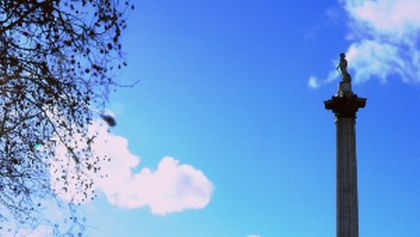
HD VERSION (1920 x 1080 px)
The column and statue of Admiral Lord Nelson in Trafalgar Square in the centre of London. The statue and tree are silhouetted against a blue sky with white clouds in this timelapse, shot over 1 hour. 13 seconds
To buy the Web (320 x 180 px) version click here
For a watermarked preview click here and use the download link
More about Trafalgar Square –
Trafalgar Square is a public space and tourist attraction in central London, built around the area formerly known as Charing Cross. It is situated in the City of Westminster. At its centre is Nelson’s Column, which is guarded by four lion statues at its base. There are a number of commemorative statues and sculptures in the square, while one plinth, left empty since it was built in 1840, The Fourth Plinth, has been host to contemporary art since 1999. The square is also used for political demonstrations and community gatherings, such as the celebration of New Year’s Eve.
The name commemorates the Battle of Trafalgar, a British naval victory of the Napoleonic Wars over France and Spain which took place on 21 October 1805 off the coast of Cape Trafalgar in Los caños de meca, a town in the municipality of Vejer de la Frontera (in the municipality of Barbate since 1940), Cádiz, Spain. The original name was to have been “King William the Fourth’s Square”, but George Ledwell Taylor suggested the name “Trafalgar Square”.
In the 1820s George IV engaged the architect John Nash to redevelop the area. Nash cleared the square as part of his Charing Cross Improvement Scheme. The present architecture of the square is due to Sir Charles Barry and was completed in 1845.
Trafalgar Square is owned by the Queen in Right of the Crown and managed by the Greater London Authority, while Westminster City Council owns the roads around the square, including the pedestrianised area of the North Terrace. It forms part of the Northbank business improvement district.
More about Trafalgar Square –
Trafalgar Square is a public space and tourist attraction in central London, built around the area formerly known as Charing Cross. It is situated in the City of Westminster. At its centre is Nelson’s Column, which is guarded by four lion statues at its base. There are a number of commemorative statues and sculptures in the square, while one plinth, left empty since it was built in 1840, The Fourth Plinth, has been host to contemporary art since 1999. The square is also used for political demonstrations and community gatherings, such as the celebration of New Year’s Eve.
The name commemorates the Battle of Trafalgar, a British naval victory of the Napoleonic Wars over France and Spain which took place on 21 October 1805 off the coast of Cape Trafalgar in Los caños de meca, a town in the municipality of Vejer de la Frontera (in the municipality of Barbate since 1940), Cádiz, Spain. The original name was to have been “King William the Fourth’s Square”, but George Ledwell Taylor suggested the name “Trafalgar Square”.
In the 1820s George IV engaged the architect John Nash to redevelop the area. Nash cleared the square as part of his Charing Cross Improvement Scheme. The present architecture of the square is due to Sir Charles Barry and was completed in 1845.
Trafalgar Square is owned by the Queen in Right of the Crown and managed by the Greater London Authority, while Westminster City Council owns the roads around the square, including the pedestrianised area of the North Terrace. It forms part of the Northbank business improvement district.
Nelson’s Column –
Nelson’s Column is a monument in Trafalgar Square in central London built to commemorate Admiral Horatio Nelson, who died at the Battle of Trafalgar in 1805. The monument was constructed between 1840 and 1843 to a design by William Railton at a cost of £47,000. It is a column of the Corinthian order built from Dartmoor granite. The four bronze lions on the base were designed by Sir Edwin Landseer and were added in 1867.
The pedestal is decorated with four bronze relief panels, each 18 feet (5.5 m) square, cast from captured French guns. They depict the Battle of Cape St Vincent, the Battle of the Nile, the Battle of Copenhagen and the Death of Nelson at Trafalgar. The sculptors were Musgrave Watson, William F. Woodington, John Ternouth and John Edward Carew respectively.
The 5.5-metre (18 ft 1 in) statue at the top was sculpted by Edward Hodges Baily R.A. from three pieces of Craigleith sandstone donated by the Duke of Buccleuch, former chairman of the Nelson Memorial Committee, from his own quarries.
The column was refurbished in 2006, during which time it was scaffolded from top to bottom for access. Steam cleaning was used together with gentle abrasives to minimise any harmful impact on the bronze and stonework. The £420,000 cost was covered by Zurich Financial Services, which advertised on the scaffolding for the duration of the work. Before restoration began, laser surveys were taken during which it was found that the column was significantly shorter than the usually quoted 185 feet (56.4 m). In fact, it measures 169 feet (51.5 m) from the bottom of the first step to the tip of the admiral’s hat.

